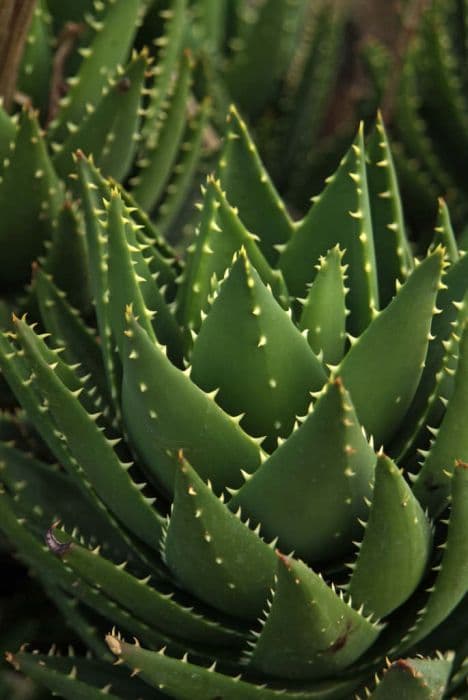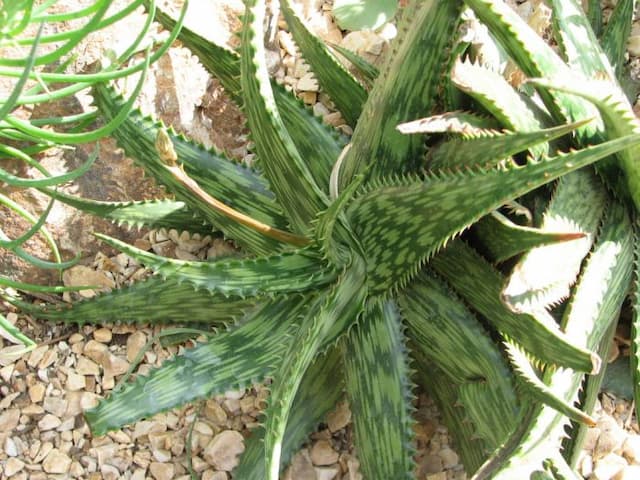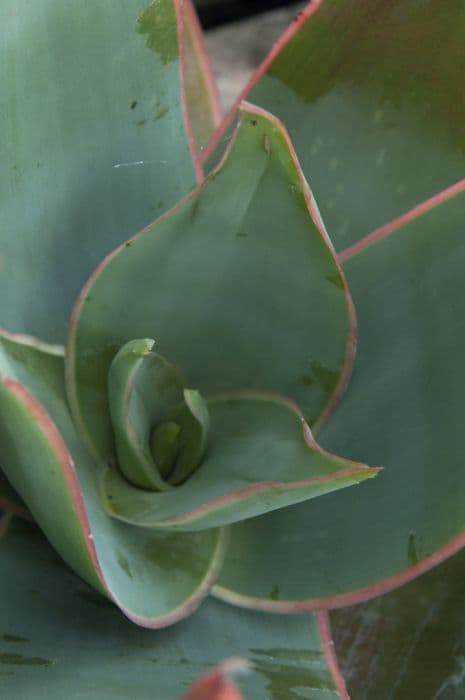Fan Aloe Aloe plicatilis

ABOUT
The Aloe plicatilis, commonly known as the Fan Aloe, has a very distinctive and striking appearance. What sets this plant apart is the unique way its leaves are arranged. The leaves are fleshy and grey-green in color, growing in a distinct fan-like pattern, which gives the plant its common name. These broad, flat leaves are borne at the end of branches and are grouped in a bilateral symmetry, meaning that the leaf pairs are mirror images on either side of the stem. The leaves are succulent, which means they are thick and fleshy, adapted to store water. This characteristic makes the Fan Aloe particularly resilient and capable of withstanding dry conditions. The edge of each leaf is smooth, without any thorns or serrations, which is somewhat unusual among aloe plants that often have spiky leaf margins. During the blooming season, the Fan Aloe produces clusters of tubular flowers. These flowers are typically a striking reddish-orange color, forming a sharp contrast with the greenery of the leaves. The blooms appear on long stems that rise above the foliage, creating a visually appealing display. The flowering stems are unbranched and can present a substantial number of flowers that are attractive to various pollinators. In terms of overall form, the Fan Aloe has a shrubby and branching habit, which along with its fan-like foliage arrangement creates an attractive and architecturally interesting silhouette. It is often used in landscaping for its ornamental appeal and drought-tolerant properties. The Fan Aloe's visually unique structure and the contrast between its grey-green leaves and vibrant flowers make it a favorite among garden enthusiasts and those who appreciate unusual plant forms.
About this plant
 Names
NamesFamily
Asphodelaceae
Synonyms
Fan Aloe, Kumara Plicatilis, Book Aloe
Common names
Kumara plicatilis, Aloe plicatilis var. plicatilis, Aloiampelos plicatilis.
 Toxicity
ToxicityTo humans
The Aloe plicatilis, commonly known as "Fan Aloe," is not widely recognized as a toxic plant to humans. However, as with many plants within the Aloe genus, the latex from the leaves, which is the yellow sap found just below the skin of the leaves, can contain compounds such as anthraquinones that may act as a laxative if ingested. This could lead to gastrointestinal symptoms such as diarrhea if consumed in significant quantities. In general, it is advisable to avoid ingesting any part of ornamental plants, including the Fan Aloe, due to the possibility of individual sensitivities and the potential for mild stomach upset.
To pets
The Fan Aloe is not commonly listed as a toxic plant to pets, but the general rule for the Aloe genus is that it can potentially cause issues if ingested. For animals, especially cats and dogs, ingesting Aloe vera can lead to symptoms such as vomiting, diarrhea, lethargy, and changes in urine color. This could potentially happen with Aloe plicatilis as well, considering the similarities between species within the Aloe genus. Pet owners should therefore exercise caution and prevent pets from ingesting any part of the Fan Aloe plant to avoid gastrointestinal distress or more severe symptoms.
 Characteristics
CharacteristicsLife cycle
Perennials
Foliage type
Evergreen
Color of leaves
Green
Flower color
Red
Height
5 feet (1.5 meters)
Spread
2 feet (0.6 meters)
Plant type
Tree
Hardiness zones
9
Native area
South Africa
Benefits
 General Benefits
General Benefits- Decorative Appeal: The Aloe plicatilis, commonly known as Fan Aloe, has unique fan-like leaf arrangement which is visually striking and adds an exotic touch to landscapes and gardens.
- Drought Tolerant: Being a succulent, Fan Aloe is highly resistant to drought, making it an ideal plant for arid climates and water-wise gardens.
- Easy Maintenance: It requires minimal care, thriving on neglect, which makes it suitable for gardeners of all skill levels, including beginners.
- Cold Resistance: Fan Aloe can tolerate cooler temperatures better than many other aloe species, able to withstand light frost and cooler weather.
- Attracts Wildlife: The bright orange-red flowers of the Fan Aloe can attract nectar-feeding birds like sunbirds and hummingbirds, supporting local biodiversity.
- Container Gardening: This plant is suitable for container gardening, allowing it to be positioned on patios, balconies, and even indoors if there is enough light.
- Firescaping: Its succulent nature gives it fire-resistant properties, making it a suitable choice for fire-prone areas when included in firescaping plans.
- Soil Erosion Control: Fan Aloe has a sturdy root system that helps stabilize the soil, preventing erosion on slopes and in areas with loose soil.
 Medical Properties
Medical Properties- Anti-inflammatory: Aloe plicatilis may contain compounds that reduce inflammation similarly to other Aloe species.
- Wound healing: The gel from Aloe plicatilis leaves is used traditionally to aid in the healing of minor wounds and burns.
- Skincare: The juice or gel found in the leaves could be beneficial for skin hydration and possibly in treating certain skin conditions.
 Air-purifying Qualities
Air-purifying QualitiesThis plant is not specifically known for air purifying qualities.
 Other Uses
Other Uses- Aloe plicatilis, commonly known as the Fan Aloe, can be used in bonsai due to its interesting fan-like leaf arrangement and tree-like growth habit, making it an attractive miniature tree after careful training and pruning.
- The thick, fleshy branches of the Fan Aloe can be used in floral arrangements and as an intriguing, long-lasting element in bouquets or table centerpieces.
- The wood from the Fan Aloe, once dried and treated, may be carved into small decorative items or tools, capitalizing on its unique texture and appearance.
- Gardeners may propagate the Fan Aloe for use as rootstock in grafting other succulents, taking advantage of its sturdy structure and resilience.
- Fan Aloe can be cultivated for its unique silhouette to create living sculptures or for use in thematic gardens where its shape can mimic ocean coral or other natural forms.
- Its strong architectural presence makes Fan Aloe an excellent candidate for adding dramatic effect to minimalist or contemporary garden designs.
- Eco-friendly landscapers may use Fan Aloe plants for xeriscaping, which reduces or eliminates the need for supplemental water from irrigation.
- Fan Aloe's tall, sturdy structure makes it a natural choice for creating privacy screens or green borders in a garden setting.
- When used in outdoor classroom settings, the Fan Aloe can serve as a living example to teach about water conservation strategies and adaptations of arid-region plants.
- Fan Aloe can be planted as part of fire-resistant landscaping, contributing to a defensible space in fire-prone regions due to its high water content and low flammability.
Interesting Facts
 Feng Shui
Feng ShuiThe Fan Aloe is not used in Feng Shui practice.
 Zodiac Sign Compitability
Zodiac Sign CompitabilityThe Fan Aloe is not used in astrology practice.
 Plant Symbolism
Plant Symbolism- Healing and Protection: Like other aloe species, the Fan Aloe is often associated with healing due to its medicinal properties, symbolizing health, well-being, and the protective nature of caring for oneself or others.
- Endurance and Resilience: The Fan Aloe's ability to thrive in arid environments and survive with minimal water symbolizes endurance and resilience in the face of hardship.
- Beauty and Uniqueness: With its distinctive fan-like leaf arrangement, the Fan Aloe represents beauty and uniqueness, reminding us to appreciate the diverse forms of beauty in the world.
- Purity: The Fan Aloe's clear gel is often regarded as a symbol of purity and cleansing, purporting to clear out negativity and maintain clarity in thoughts and surroundings.
 Water
WaterThe Fan Aloe should be watered sparingly, as it is susceptible to root rot if overwatered. Allow the soil to dry out completely between watering sessions. Typically, watering once every two to three weeks should suffice, but this may vary depending on the humidity and temperature of your environment. When you do water, give the plant a thorough soaking until water runs out of the drainage holes at the bottom of the pot, which might amount to approximately 8-16 ounces for a small pot. During the winter months, reduce watering frequency as the plant goes into a dormant period.
 Light
LightThe Fan Aloe prefers bright, indirect sunlight and should be placed in a location where it can receive plenty of light without being exposed to harsh, direct sunlight for extended periods, which can scorch its leaves. A spot near a south or west-facing window with some light shading is ideal. Consider using sheer curtains to filter the intense midday sun, ensuring the plant gets the light it needs without the associated risks.
 Temperature
TemperatureFan Aloe thrives in warm temperatures and will do best in an environment that maintains a temperature between 60-75 degrees Fahrenheit. It can tolerate a minimum temperature of around 50 degrees Fahrenheit, but should not be exposed to temperatures below this as it can cause damage to the plant. The ideal temperature range encourages healthy growth and flowering.
 Pruning
PruningPruning the Fan Aloe is generally done to remove dead or damaged leaves and to maintain an attractive shape. Prune sparingly, only as needed, using clean, sharp shears to avoid damaging the plant. The best time to prune is early spring before the plant enters its active growth phase. Pruning at this time allows the plant to quickly heal and redirect energy to new growth.
 Cleaning
CleaningAs needed
 Soil
SoilFan Aloe prefers a well-draining cactus mix with added pumice or perlite. The ideal soil pH for Fan Aloe ranges from 6.0 to 8.0, slightly acidic to alkaline. Ensure the container has drainage holes to prevent waterlogging.
 Repotting
RepottingFan Aloe should be repotted every two to three years to refresh the soil and provide space for growth. Repotting is best done in the spring or early summer.
 Humidity & Misting
Humidity & MistingFan Aloe thrives in low to average humidity levels typical of indoor environments. There is no need for high humidity; standard room levels are adequate.
 Suitable locations
Suitable locationsIndoor
Place Fan Aloe in a sunny window, water sparingly.
Outdoor
Position in full sun with well-draining soil, protect from frost.
Hardiness zone
9-11 USDA
 Life cycle
Life cycleAloe plicatilis, commonly known as Fan Aloe, begins its life as a seed that germinates in well-draining, sandy soils with adequate warmth and moisture. Upon sprouting, the seedling develops fleshy leaves arranged in a fan-like rosette pattern, typical of this species, and a root system that absorbs water and nutrients. As the plant matures, it undergoes a vegetative state where it grows larger, with the rosette becoming more pronounced and sometimes producing offsets or "pups" at its base. The Fan Aloe reaches sexual maturity in several years, signified by the emergence of a tall flowering stalk bearing tubular red or orange flowers that attract pollinators like birds and bees. After pollination, the flowers produce seeds that are eventually dispersed by wind or gravity. With a potential lifespan extending over many decades, mature plants will repeatedly enter a flowering cycle, thus continuing the perpetuation of the species.
 Propogation
PropogationPropogation time
Spring to Summer
The Aloe plicatilis, commonly known as the Fan Aloe, is best propagated through offsets, which are small shoots or pups that grow at the base of the parent plant. This method is most popular because it is simple and usually very successful. The ideal time to propagate by offsets is during the warmer months when the plant is actively growing, typically in late spring or early summer. To propagate Fan Aloe, carefully remove the offsets from the parent plant using a clean, sharp knife, ensuring each offset has some roots attached if possible. Let the cuttings dry for a day or two to form a callus over the cut surface, which helps prevent rotting when planted. Plant the offsets in a well-draining soil mix, and water moderately to establish the new plants. Over the course of weeks, with sufficient light and warmth, these offsets will root and grow into independent specimens of the vibrant Fan Aloe.









